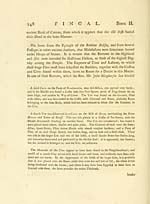Ossian Collection > Fingal of Ossian
(247)
Download files
Complete book:
Individual page:
Thumbnail gallery: Grid view | List view

Book II. F I N G A L. 149
broke open, there were four different Coffins placed at fome DIftance from
a larger one in the Centre. Each of thefe contained an Urn with A(hes
and fome half-burnt Bones. The Coffin or Cheft in the Middle was cer-
tainly the Repofitory of a great Chieftain or King, and thofe around be-
longed to Perfons who v/ere either his near Relations, or Heroes of a lefs
exalted Charadler.
There is a proverbial Exprefllon common in the Highlands and IJlands
to this Day, from which we may form a Conjefture of the Manner of
erefling thefe Piles, and the Ufe for which they were intended. The
Expreffion is, I Jhall add a Stone to your Cairn; that is to fay, I ffiall do
your Memory all the Honour in my Power, when you are no more. I
fiiall contribute to raife your Monument. This is the Language of Peti-
tioners, when fenfible the Favours they afk cannot in all Probability be
fufficiently acknowledged till after the Benefadlor's Death. The religious
Belief of thofe Times obliged every pious Traveller to add a Stone to the
Pile of the Dead. The larger the Stone, the more to the Honour of the
departed Spirit, which was thought to hover round his Heap, and to re-
joice over the Piety of the Traveller. If the Cairn belonged to a Man of
diltinguiffied Merit, who died in the Caufe of his Tribe, or was reared in
Memory of a famous Bard, the whole Community came on appointed
Days to increafe the Pile, and fend it down with Luftre to Pofterity.
Hence we may account for the Bulk of thofe little Hills, though reared in
Times when Carriages and mechanical Engines of all Kinds were little
known.
FIN GAL,
broke open, there were four different Coffins placed at fome DIftance from
a larger one in the Centre. Each of thefe contained an Urn with A(hes
and fome half-burnt Bones. The Coffin or Cheft in the Middle was cer-
tainly the Repofitory of a great Chieftain or King, and thofe around be-
longed to Perfons who v/ere either his near Relations, or Heroes of a lefs
exalted Charadler.
There is a proverbial Exprefllon common in the Highlands and IJlands
to this Day, from which we may form a Conjefture of the Manner of
erefling thefe Piles, and the Ufe for which they were intended. The
Expreffion is, I Jhall add a Stone to your Cairn; that is to fay, I ffiall do
your Memory all the Honour in my Power, when you are no more. I
fiiall contribute to raife your Monument. This is the Language of Peti-
tioners, when fenfible the Favours they afk cannot in all Probability be
fufficiently acknowledged till after the Benefadlor's Death. The religious
Belief of thofe Times obliged every pious Traveller to add a Stone to the
Pile of the Dead. The larger the Stone, the more to the Honour of the
departed Spirit, which was thought to hover round his Heap, and to re-
joice over the Piety of the Traveller. If the Cairn belonged to a Man of
diltinguiffied Merit, who died in the Caufe of his Tribe, or was reared in
Memory of a famous Bard, the whole Community came on appointed
Days to increafe the Pile, and fend it down with Luftre to Pofterity.
Hence we may account for the Bulk of thofe little Hills, though reared in
Times when Carriages and mechanical Engines of all Kinds were little
known.
FIN GAL,
Set display mode to: Large image | Transcription
Images and transcriptions on this page, including medium image downloads, may be used under the Creative Commons Attribution 4.0 International Licence unless otherwise stated. ![]()
| Early Gaelic Book Collections > Ossian Collection > Fingal of Ossian > (247) |
|---|
| Permanent URL | https://digital.nls.uk/77604838 |
|---|
| Description | Selected books from the Ossian Collection of 327 volumes, originally assembled by J. Norman Methven of Perth. Different editions and translations of James MacPherson's epic poem 'Ossian', some with a map of the 'Kingdom of Connor'. Also secondary material relating to Ossianic poetry and the Ossian controversy. |
|---|
| Description | Selected items from five 'Special and Named Printed Collections'. Includes books in Gaelic and other Celtic languages, works about the Gaels, their languages, literature, culture and history. |
|---|

